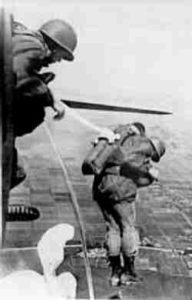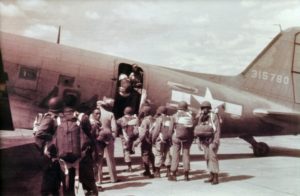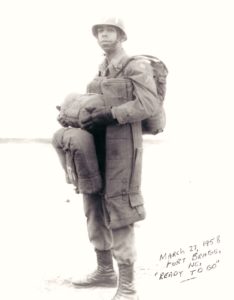 Ever since World War II, the Army Airborne has been an elite U.S. military fighting force. Because of their mobility and fierce fighting skills, paratroop units have long been relied upon for major quick-strike campaigns, often parachuting behind enemy lines to perform critical missions.
Ever since World War II, the Army Airborne has been an elite U.S. military fighting force. Because of their mobility and fierce fighting skills, paratroop units have long been relied upon for major quick-strike campaigns, often parachuting behind enemy lines to perform critical missions.
Membership in legendary divisions such as the 82nd Airborne (the “All American Division”) and the 101st Airborne (the “Screaming Eagles’) have always been deemed a high military honor. The strongest and most able of the U.S. military have competed hard to join these famed units.
But soldiers of color were not always welcome in the airborne. When paratroop divisions were first organized in the early 1940s, black soldiers were not deemed fit for the demanding service. Military leaders of the era believed black soldiers lacked the courage and brains to meet the demands required of a paratrooper.
This was nothing new for the army. As told in my novel A Place near the Front, the army fought hard to undermine World War One black officers, the first ever commissioned in U.S. military history.
When they were blocked from joining the then all-white airborne units, a group of black soldiers fought hard to have the army establish a 20-member all-black “test-platoon” to allow soldiers of color to showcase their skills and prove they had the right stuff to fight with elite units.

These black pioneers were exceptional men, specially selected for the task. They were former university students and professional athletes, top-notch and veteran non-coms. A major element in their success was that, unlike other black infantry units headed by white officers, they were entirely black, from commanding officer down to the newest private.
Though combat-ready and alerted for European duty in late 1944, the changing tides of the World War II resulted in a different assignment – jumping over the blazing forests of the American Northwest searching for Japanese balloon bombs, a job requiring exact skills and special courage. In this unusual role, the test platoon, now called the 555th Parachute Infantry (nicknamed the “Triple Nickles”), also confronted a new dimension in warfare involving the use of biological agents that could destroy woodlands and crops, but not humans. These men soon became known as the “SmokeJumpers.”

In early 1945 the “Triple Nickles” received secret orders for a permanent change of station. They were sent to Pendleton, Oregon and trained by the U.S. Forest Service, becoming history’s first military smokejumpers. There were two reasons for this assignment. First, senior commanders in Europe were leery of having highly trained colored paratroopers coming into contact with racist white elements of the time. Second, the Japanese were at the time floating incendiary devices attached to balloons across the Pacific Ocean, taking advantage of the jet stream’s easterly flow, in an attempt to start forest fires in the northwestern United States.  The Forest Service asked the military for help and the “Triple Nickle” was ready, willing and able. The battalion answered some 36 fire calls with more than 1,200 individual jumps during the summer of 1945, operating from Pendleton and Chico, Calif. The operation covered all of the north-western states including Montana. During fire operations the battalion suffered numerous injuries but only one fatality.
The Forest Service asked the military for help and the “Triple Nickle” was ready, willing and able. The battalion answered some 36 fire calls with more than 1,200 individual jumps during the summer of 1945, operating from Pendleton and Chico, Calif. The operation covered all of the north-western states including Montana. During fire operations the battalion suffered numerous injuries but only one fatality.
The Triple Nickles proved their competence, and shortly after the end of the war, black troopers became members of all major paratroop units. By the time I did my military service in the middle 1950s, black soldiers had been fully accepted into airborne units and I was fortunate enough to serve as a proud member of the 82nd Airborne.